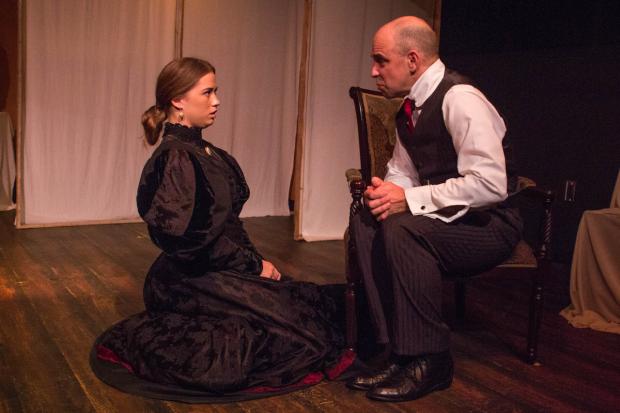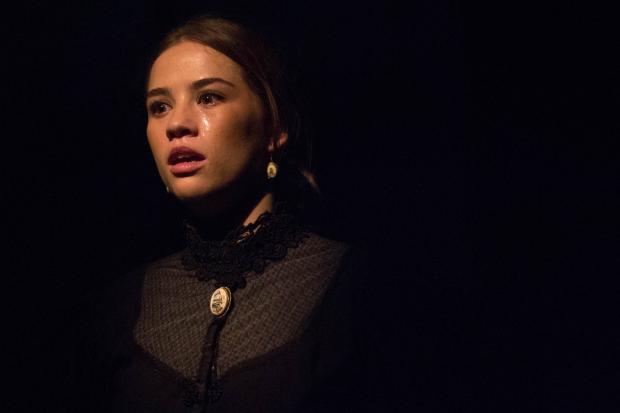Novelist Henry James’ 1898 Gothic novella The Turn of the Screw has oft been adapted for the big and little screen, opera and in its latest incarnation by playwright Jeffrey Hatcher, it’s currently scaring the bejesus out of ticket buyers at The Harold Clurman Lab Theater - just in time for Halloween. Set in 1870s England, The Woman (Australian actress Emily Sulzberger) answers a newspaper ad placed by a British gentleman (Sean Spann displays the span of his acting range in multiple parts) seeking a live-in instructor for his niece and nephew living in a posh country manor.
A young, inexperienced Victorian Era female of humble origins, The Woman in one of her soliloquies tells the audience she has a Jane Eyre-like vision of finding her aristocratic, manly Edward Rochester through her post. But in his role as The Man, Spann (who had a recent stint on The Clurman’s boards in The Road to Nirvana) warns her in a portentous aside, “The madhouses are full of governesses.” Indeed, the rural Essex estate called Bly may prove to be her insane asylum. Shortly after meeting little Flora and Miles plus the help (all portrayed by the protean Spann) there, The Woman notices lots of strange goings on there.
Your plot spoiler adverse reviewer won’t ruin the ghoulish fun for you but allow him to make a few thematic points. What underlines and underlies the story’s terror is sexual in nature. First of all, Henry James’ title could be considered innuendo alluding to intercourse. When The Man interviews the youthful aspiring governess The Woman is taken aback when he uses the term “a version” and the young lady clearly thinks her prospective employer is inquiring as to whether she is “a virgin.” (Interestingly, she never answers what she perceives the question to be. Paging: #MeToo!)
To compound matters, especially the - uh - version onstage at the Clurman, this creepy play not only deals with sex but with the topic of childhood sexuality, which is fraught with enough taboos and boo-boos to make one shout “Boo!” Screw dares to touch upon the theme of child-adult sexual encounters, which makes it a very chilling story and certainly not one to bring the kiddies or more sensitive souls (such as abuse victims and scaredy-cats like your nervous Nellie reviewer) to.
In one of the most fortuitous improv moments I’ve ever witnessed on the boards, when The Woman meets 10-year-old Miles (Spann plays the lad) Sulzberger’s Victorian dress came undone. Miles, who is older (if not wiser) than his years, spontaneously fixed Sulzberger’s costume. Director Don K. Williams later insisted that this was not in Hatcher’s script, but it melded perfectly with the theme of child sexuality in this story with its Lord of the Flies-like libidinal resonance. Quite a moment of spontaneous onstage serendipity indeed. (As Freud wrote in 1920’s The Psychology of Errors: “There is no such thing as errors.”
The Aussie Ms. Sulzberger conveys an increasing hysteria, as The Woman’s aspiration devolves from finding Mr. Right to encountering sheer terror. But with his continually shifting roles (with only slight costume modifications), this is really Mr. Spann’s production, as he steals the show with his onstage morphing - or “turning,” as the case may be.
This is not the only time that actors have mounted multiple roles at the Clurman. In the intimate theatre’s 2014 revival of playwright Israel Horovitz’s Lebensraum only three thesps incarnated all of the play’s 60-plus dramatis personae. Williams also helmed, with great panache, this play about Jews’ right to return (but with a twist). For Screw the director told me, “Hatcher calls for no sound, one chair, two actors and no props. He explicitly states that he wants it done as minimally as possible.” The only thing Hatcher required that the theatre couldn’t provide for its low budge production was “a staircase.” Williams, who is also the Art of Acting Studio’s Managing Artistic Director, added: “I do enjoy solving these kinds of staging puzzles,” such as casting a single player to portray a multitude of roles.
Screen Screws:
As noted at the top of this review, there have been numerous TV and movie versions (not “virgins”!) of Henry James’ horror novella, which was originally serialized in Collier’s Weekly Magazine in 1898. Coming out (no pun intended) while Queen Victoria sat on the throne during her prim and proper prudish period, with its undercurrents of under-aged sexuality between children and adults, et al, it must have been shocking, at least on a subliminal level.
A favorite novelist of domestic and foreign filmmakers, screen adaptations of James’ fiction began appearing by 1933, and some of them have been doozies: William Wyler directed Montgomery Clift in his third feature opposite Olivia de Havilland in 1949’s The Heiress; Peter Bogdanovich’s 1974 Daisy Miller starred Cybill Shepherd; James Ivory’s 1984 The Bostonians featured Christopher Reeves, Vanessa Redgrave and Jessica Tandy (remade in 1997 by Agnieszka Holland with Albert Finney, Maggie Smith); 1997’s The Wings of the Dove starred Helena Bonham Carter, etc.
But James’ most-adapted work for cinema and television is certainly The Turn of the Screw. I believe the first version starred Geraldine Page in 1955 in the TV series Omnibus, its teleplay by none other than Gore Vidal. There have been about 19 big and little screen Screw versions, including in various European languages, and of course in 1954 Benjamin Britten composed an operatic version, which LA Opera presented a few years ago.
The most notable Miss Giddens (the governess) was Deborah Kerr in the 1961 British film The Innocents. It’s interesting to note that the best male actor associated with the Screw adaptations is the most stellar student of Stella Adler, whose imprimatur and techniques as the avatar of the Stanislavsky Method is an essential element of the Art of Acting Studio and its Harold Clurman Lab Theater (Clurman and Stella were married and guiding lights of the hallowed Group Theatre).
Stella’s peerless pupil Marlon Brando starred as Peter Quint in 1971’s The Nightcomers, directed by British helmer Michael Winner. This cult classic is overlooked by most “Marlon-ologists” because it came out after his meteoric movie run during the 1950s, released when his star had faded in Hollywood and Brando was apparently cranking out pictures to pay the bills, and before his luster was restored by his Oscar-winning (if refused) turn in 1972’s The Godfather. Nevertheless, not only does Brando deliver a breathtakingly idiosyncratic performance as Quint in The Nightcomers but other than 1972’s Last Tango in Paris it’s Marlon’s most sexually graphic screen role.
FUN FACT OF THE REVIEW:
The motion picture that may have dimmed Brando’s star power in the Hollywood firmament was probably 1962’s costly Mutiny on the Bounty, wherein he depicted the real life mutineer, Fletcher Christian, who toppled the cruel Captain Bligh (Trevor Howard) in the British Navy’s most famous revolt. Now, get a load of this: The estate where Screw’s action is set is called “Bly” and its disturbing Henry James character named “Peter Quint” (played by Brando in The Nightcomers). Real life sailor Matthew QUINTal (played by actor Percy Herbert) was flogged by Captain Bligh and became one of the mutineers aboard the Bounty. At their refuge in uncharted Pitcairn Island he burned the Bounty so nobody could leave the remote isle and wrought lots of mayhem at the tropical outpost.
“Bounty-ologists” can’t help but wonder whether or not Henry James may have been alluding to the Bounty saga in his choice of names in Screw? Inquiring minds want to know and any case, the fact that Brando starred in Mutiny on the Bounty and nine years later went on to play a character called “Quint” is, at the very least, an interesting coinky-dinky.
(BTW, in 2019 the French Polynesia-based cargo-cruiser Aranui is for the first time ever sailing to Pitcairn and I will present a film festival aboard Aranui called “A Bounty of Bountys” to commemorate the 230th anniversary of the true life mutiny on the Bounty. See: https://aranui.com/pitcairn-cruise/.)
The final curtain for the Clurman’s Screw is on the ideal night for this chilling classic: Halloween. If that last performance is sold out (like the theater was the night I attended), don’t despair, Dear Viewer: In 2019, yet another movie version of Henry James’ horror story will be released!
The Harold Clurman Lab Theater is presenting The Turn of the Screw on Saturdays at 8:00 p.m. and Sundays at 7:00 p.m. with a final performance on Halloween - Wednesday, Oct. 31, 8:00 p.m. Heads up: there is construction near the theater but street parking is available near the Art of Acting Studio, 1017 N. Orange Drive, L.A., CA 90038. For more information: (323)601-5310; https://web.ovationtix.com/trs/pr/999287.
L.A.-based film historian/critic Ed Rampell is co-author/author of four movie film history books, including “The Hawaii Movie and Television Book” (see: https://mutualpublishing.com/product/the-hawaii-movie-and-television-book/ ).



